
The Burgundians were an early Germanic tribe or group of tribes. They appeared in the middle Rhine region, near the Roman Empire, and were later moved into the empire, in eastern Gaul. They were possibly mentioned much earlier in the time of the Roman Empire as living in part of the region of Germania that is now part of Poland.
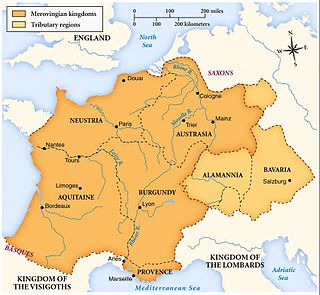
The Merovingian dynasty was the ruling family of the Franks from the middle of the 5th century until 751. They first appear as "Kings of the Franks" in the Roman army of northern Gaul. By 509 they had united all the Franks and northern Gallo-Romans under their rule. They conquered most of Gaul, defeating the Visigoths (507) and the Burgundians (534), and also extended their rule into Raetia (537). In Germania, the Alemanni, Bavarii and Saxons accepted their lordship. The Merovingian realm was the largest and most powerful of the states of western Europe following the breaking up of the empire of Theodoric the Great.
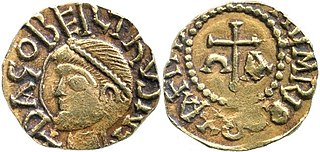
Dagobert I was the king of Austrasia (623–634), king of all the Franks (629–634), and king of Neustria and Burgundy (629–639). He has been described as the last king of the Merovingian dynasty to wield any real royal power. Dagobert was the first of the Frankish kings to be buried in the royal tombs at Saint Denis Basilica.
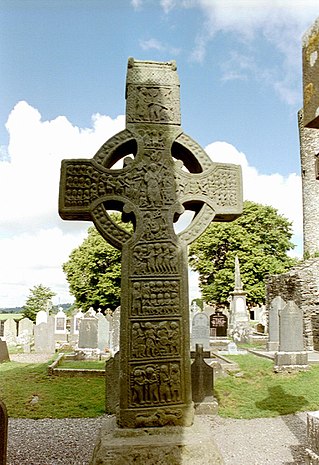
A high cross or standing cross is a free-standing Christian cross made of stone and often richly decorated. There was a unique Early Medieval tradition in Ireland and Britain of raising large sculpted stone crosses, usually outdoors. These probably developed from earlier traditions using wood, perhaps with metalwork attachments, and earlier pagan Celtic memorial stones; the Pictish stones of Scotland may also have influenced the form. The earliest surviving examples seem to come from the territory of the Anglo-Saxon kingdom of Northumbria, which had been converted to Christianity by Irish missionaries; it remains unclear whether the form first developed in Ireland or Britain.

Chlothar III was the eldest son of Clovis II, king of Neustria and Burgundy, and his queen Balthild. When Clovis died in 657, Chlothar succeeded him under the regency of his mother. Only a month beforehand, according to the near-contemporary Life of Eligius by the courtier Audoin (bishop) of Rouen, Saint Eligius had prophesied the death of Clovis, Balthild's downfall, and Chlothar's short reign.

Childeric II was the king of Austrasia from 662 and of Neustria and Burgundy from 673 until his death, making him sole King of the Franks for the final two years of his life.

Childeric III was King of Francia from 743 until he was deposed by Pope Zachary in 751 at the instigation of Pepin the Short. Although his parentage is uncertain, he is considered the last Frankish king from the Merovingian dynasty. Once Childeric was deposed, Pepin the Short, who was the father of emperor Charlemagne, was crowned king, initiating the Carolingian dynasty.

Gundobad was King of the Burgundians, succeeding his father Gundioc of Burgundy. Previous to this, he had been a patrician of the moribund Western Roman Empire in 472 – 473, three years before its collapse, succeeding his uncle Ricimer. He is perhaps best known today as the probable issuer of the Lex Burgundionum legal codes, which synthesized Roman law with ancient Germanic customs. He was the husband of Caretene.

Athanagild was Visigothic King of Hispania and Septimania. He had rebelled against his predecessor, Agila I, in 551. The armies of Agila and Athanagild met at Seville, where Agila met a second defeat. Following the death of Agila in 554, he was sole ruler for the rest of his reign.

Chlodomer, also spelled Clodomir or Clodomer was the second of the four sons of Clovis I, King of the Franks. On the death of his father, in 511, he divided the kingdom of the Franks with his three brothers: Theuderic I, Childebert I, and Chlothar I. Although Theuderic, the eldest, had a better claim, Chlodomer divided half of the kingdom with his two other brothers. This was the kingdom of Orléans, taken from the former kingdom of Syagrius. This kingdom included, most notably, the bishoprics of Tours, Poitiers and Orléans. Chlodomer married Guntheuc, with whom he had three sons: Theodebald, Gunthar, and Clodoald.

Alcimus EcdiciusAvitus was a Latin poet and bishop of Vienne in Gaul. His fame rests in part on his poetry, but also on the role he played as secretary for the Burgundian kings.
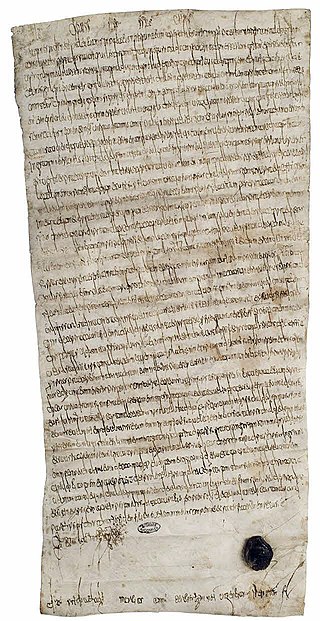
Clovis IV was the king of the Franks from 690 or 691 until his death. If the brief reign of Clovis III (675) is ignored as a usurpation, then Clovis IV may be numbered Clovis III.

Charibert II, a son of Clotaire II and his junior wife Sichilde, was briefly King of Aquitaine from 629 to his death, with his capital at Toulouse. There are no direct statements about when Charibert was born exactly, the only known fact being that he was "a few years younger" than his half-brother Dagobert. His father Clotaire evidently had a bigamous marriage and he was the offspring of the junior wife.

The Ruthwell Cross is a stone Anglo-Saxon cross probably dating from the 8th century, when the village of Ruthwell, now in Scotland, was part of the Anglo-Saxon Kingdom of Northumbria.

The Bewcastle Cross is an Anglo-Saxon cross which is still in its original position within the churchyard of St Cuthbert's church at Bewcastle, in the English county of Cumbria. The cross, which probably dates from the 7th or early 8th century, features reliefs and inscriptions in the runic alphabet. The head of the cross is missing but the remains are 14.5 feet high, and almost square in section 22 by 21+1⁄4 inches at the base. The crosses of Bewcastle and Ruthwell have been described by the scholar Nikolaus Pevsner as "the greatest achievement of their date in the whole of Europe".
Odilo, also Oatilo or Uatilo of the Agilolfing dynasty was Duke of Bavaria from 737 until his death in 748. He had the Lex Baiuvariorum compilation edited, the first ancient Germanic law collection of the Bavarians.
The Northumbrian Renaissance or Northumbria's Golden Age is the name given to a period of cultural flowering in the Anglo-Saxon kingdom of Northumbria, broadly speaking from the mid-seventh to the mid-eighth centuries. It is characterised by a blend of insular art, Germanic art and Mediterranean influence. Authors associated with this golden age include Bede and Alcuin; artefacts include the Lindisfarne Gospels and associated manuscripts, the Ruthwell Cross and associated sculptures, and, arguably, the Franks Casket. An illustration of the cultural activity of Northumbria during this period is given by Alcuin's De Sanctis et Pontificibus Ecclesiæ Eboracensis, which gives particular attention to Bishop Æthelbert of York.
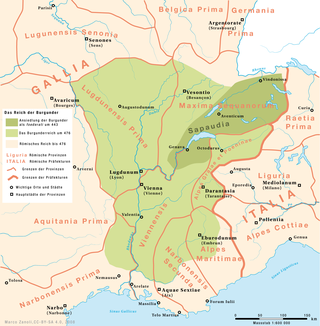
The Kingdom of the Burgundians or First Kingdom of Burgundy was established by Germanic Burgundians in the Rhineland and then in eastern Gaul in the 5th century.
Fred Lionel Orton is an English art historian. His initial training was at Coventry College of Art in painting as a Dip.A,D student. He extended his experience in the History and Development of Art initially at the Courtauld Institute in London and then professionally as a scholar of art history and art theory at the University of Leeds.
Lantechildis was a Frankish noblewoman, the daughter of the Frankish king Childeric I (d. 481) and the Thuringian noblewoman Basina (d. 477). She was a sister of Clovis I. She is mentioned in Gregory of Tours and the Liber historiae Francorum.
















